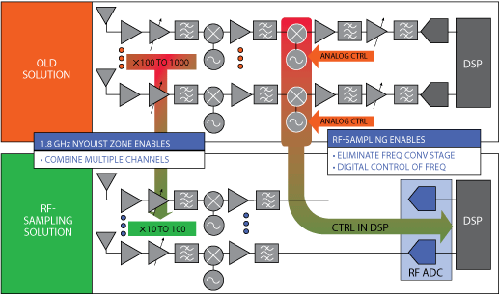 | |||
| Conventional ESM/RWR Receiver Architecture may be ineffective against modern radars |
Signal Sorting Methods and Direction Finding - RF Cafe
 |
| reduction in analog components allows sophisticated and adaptive signal processing |
 |
| One Possible Advanced EW Receiver Architecture FinderPlus | Aeronix |
FBO # FA8604-15-R-7001
SPECIAL NOTICE
REQUEST FOR INFORMATION (RFI) on Future Electronic Warfare
(EW) Receiver Systems
(EW) Receiver Systems
Response Due: 23 January 2015
Purpose:
The objective of this RFI is to give the Air Force Research Laboratory (AFRL) and the Air Force Life Cycle Management Center (AFLCMC) the information needed to develop a near to mid-term (present-2025) technology roadmap including required investment funding to advance the state of practice of EW receiver technology and architecture to address modern and future radar agile threat waveforms. AFRL and AFLCMC/XZ will utilize this data to identify potential technology investment and maturation efforts needed to develop next generation receiver systems.RFI Objectives:
- Overall future architecture concept: Please identify the specific functions you believe each subsystem in your architectures should accomplish. What kinds of threat signal parameters need to be measured and how that information would be used in a system? These may differ for the different applications such as RWR/SA, jammer support, and ISR receivers.
- Hardware/Firmware/Software technology needs: Please identify the types of technology that need to be developed/refined to fully implement your concepts. Include an assessment of the technology readiness of critical components and define needed maturation activities.
- Mission Data Requirements:
Identify what data types will be required for the system to perform (EO/IR/RF signatures, parametric data, Order of Battle information, characteristics and performance data, etc.).
Identify if the system will utilize information available from standard DOD intelligence databases (or products). Identify any other intelligence inputs required for reprogramming and/or mission planning to include Geospatial Intelligence products. Define fidelity requirements of input data (e.g. parametric accuracy, minimum resolution values, and acceptable data confidence levels, acceptability of modeled versus collected/observed data, etc.) - Potential system interfaces: Identify on-board or off-board systems that could be used to improve the performance of your concepts. Identify how your concepts will perform in the presence of onboard RF systems and those of wingmen. Identify the antenna concepts your approach needs to achieve its' desired performance.
- Test Requirements: Please identify the types of test capabilities you envision will be required to fully evaluate your receiver concepts.
- Technology Development Roadmap: Please identify your plans and estimated schedules to fully develop the necessary architectural concepts and related technologies. Identify your planned investment funding profile and expected performance over time.
- Cost and Risk Analysis: Identify and quantify risks associated with your solution(s). Be as
specific as possible in regards to potential cost and schedule impact of the identified risks. Please identify where potential government investment could be used to reduce risk and mature technologies for each proposed concept. If possible, discuss your rationale for investment funding estimates and the degree of risk associated with each element.
Related Programs Background:
Programmable radar and adaptive electronic warfare take center stage - Military & Aerospace ElectronicsDARPA electronic warfare project to counter programmable adaptive radar
Six U.S. research organizations have been chosen to participate in a military electronic warfare (EW) project to find ways to detect and counter digitally programmable radar systems that have unknown behaviors and agile waveform characteristics.Adaptive Radar Countermeasures (ARC) Proposers' Day - DARPA-SN-12-46 (Archived) - Federal Business Opportunities: Opportunities
The BAE Systems Electronic Systems segment in Merrimack, N.H., and Systems and Technology Research (STR) in Woburn, Mass., are the latest to join the Adaptive Radar Countermeasures (ARC) program of the U.S. Defense Advanced Research Projects Agency (DARPA) in Arlington, Va.
Last month, BAE Systems won a $36.7 million DARPA contract and STR won a $7.1 million contract to participate in the ARC program. Also last month, DARPA ARC contracts went to Science Applications International Corp. (SAIC) in McLean, Va., worth $31.5 million, and to Vadum Inc. in Raleigh, N.C., worth $4.1 million.
In February, Helios Remote Sensing Systems Inc. in Rome, N.Y., won a $2.9 million DARPA ARC contract, and the Michigan Tech Research Institute (MTRI) in Ann Arbor, Mich., won an $8 million DARPA ARC contract.
The DARPA ARC program seeks to develop EW capability to counter hostile adaptive radar systems based on their over-the-air signals. The program aims to counter enemy radar that senses its environment and automatically adapts to attempts to jam it.
Radar the Next Generation - Sensors as Robots
www.dtic.mil/cgi-bin/GetTRDoc?AD=ADA445488
Dr. Michael C. Wicks, AFRL Sensors Directorate E-mail: Michael.Wicks@rl.af.mil With: Mr. John
F. Spina and Dr. Gerard T. Capraro
Abstract—One can easily envision future military operations and emerging civilian requirements (e.g. intelligent unmanned vehicles for urban warfare, intelligent manufacturing plants) that will be both complex and stressing and will demand innovative sensors and sensor configurations. The goal of our research into Sensors as Robots is to develop a cost effective and extendable approach for providing surveillance for a variety of applications in dynamically changing military and civilian environments. Within Sensors as Robots, we foresee a new sensor archetype. In this paradigm, sensors and algorithms will be autonomously altered depending on the environment. Radars will use the same returns to perform detection and discrimination, to adjust the platform flight path and change mission priorities. The sensors will dynamically and automatically change waveform parameters to accomplish these goals. Disparate sensors will communicate and share data and instructions in real-time. Intelligent sensor systems will operate within and between sensor platforms such that the integration of multiple sensor data provides information needed to achieve dynamic goals and avoid electromagnetic fratricide. Intelligent sensor platforms working in partnership will increase information flow, minimize ambiguities, and dynamically change multiple sensors’ operations based upon a changing environment. Concomitant with the current emphasis on more flexible defense structures, Sensors as Robots will allow the appropriate incremental application of remote sensing assets by matching resources to the situation at hand.

No comments:
Post a Comment